 |
||
|
||
| ||
I always feel sorry for an old generation which gives way to the inexorable progress and a new generation which is always ready to go over dead bodies. Now, when the Intel Celeron lines is being transferred onto the new core, I feel sorry for once so popular Tualatin, for the Celeron family which won't reach its peak of popularity soon. (At present this line is undergoing the second splash of interest caused by the excellent combination of frequencies of the processors and their bus, prices and overclocking capabilities, availability of boards and memory). But most of all I feel sorry for the Socket 370. The whole epoch fades away... The super-successful i440BX... the most faithful fans of it were ready to attach awful adapters from PowerLeap just to make it live longer... Although by its end the socket got a lot of prefixes in the name, it still had 370 holes... The quirk of fate: the tilled, fertilized and fructiferous field is given free to VIA. Today the share of the C3 processors on the market is very small, but we believe that the current events will have a positive effect on such quiet VIA processors. Well, let's leave aside our emotions and turn to the facts. Facts and picturesSo, now the Celeron processors will be based on the Willamette core with the 128 KBytes L2 cache which is smaller than that of the original Willamette - Pentium 4, and which is called simply Willamette-128. The new processors will have the same fabrication process as the old Pentium 4 (0.18 micron), and be produced on the same factories, or rather on those parts of the factories the facilities of which are meant for the old fab process. The form-factor remains the same as well - Socket 478, which Intel is going to use for the Celeron line yet for a long time - there will be Celeron processors on the light Northwood as well.
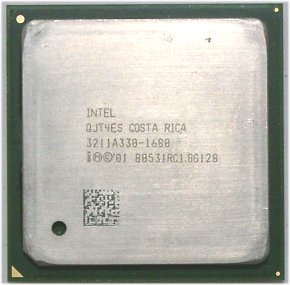 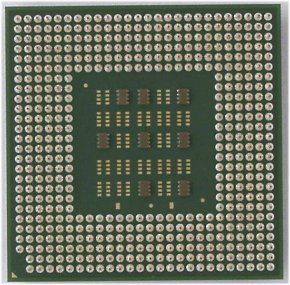 The new processors must be supported by any chisets designed for Pentium 4, but in practice... The newcomer got some problems as soon as it appeared: none of the boards, that we had, on different chipsets with the latest firmware versions (including Intel boards) failed to identify correctly the sample, in particular, they couldn't identify its L2 cache memory. However, one of the boards managed to do it, but we still couldn't find a program (including the Intel's utility) which would prove it.
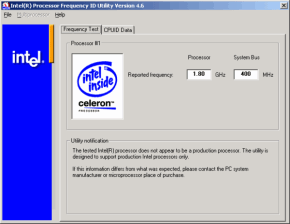 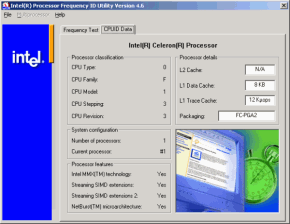 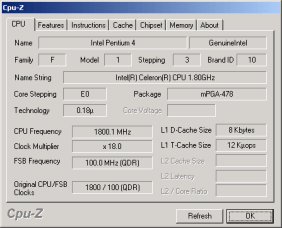 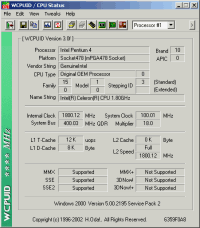 128 KBytes are really here:
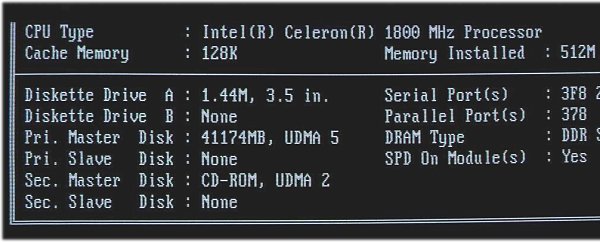 To prove that the examined processor has the L2 cache over 64 KBytes and less than 256 KBytes we used the Cachemem program to plot the diagram of read/write speed of the memory.
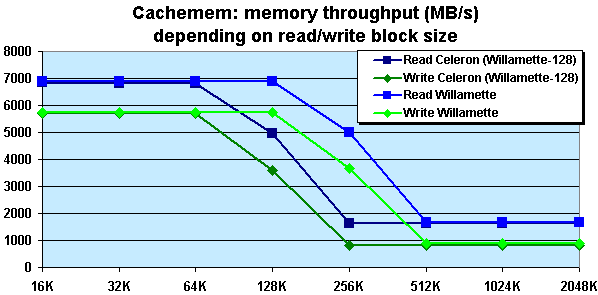 The first model of the new line is clocked at 1700 MHz, but our preproduction sample had 1800 MHz with an unlocked multiplier, that is why the results below can be ascribed to the announced Celeron 1.7 GHz. Probably because of the fact that the processor at such frequency doesn't exist officially yet it was impossible to identify it. Anyway, it will appear in the near future. Let's pop in it. PerformanceTest bed:
Software:
The Celeron version we had (the unlocked multiplier was changed) was compared with the Pentium 4 (Willamette) 1.7 GHz and Pentium 4 (Northwood) 1.8A GHz. We also overclocked Celeron 1.8 GHz to find out whether it is able to fight against the Northwood based model. The low-end processor (as it is positioned by Intel) was paired with the SiS 645DX based board - which is also a low-end model in price though its quality and speed are acceptable. Soon Intel will announce its DDR chipset for the new Celeron, but now there are no more alternatives. The memory was clocked at 266 MHz (DDR266), the timings were minimal. Such memory is much wider available as compared with the more expensive DDR333. We refused to carry out tests with the SDR SDRAM, as the performance of such system is awful - as we saw lots of times - although the cache is larger than that of the new Celeron; besides, it makes no sense to combine elements such a strange way - it's more rational to use platforms designed for processors with the Tualatin core (we don't touch upon the issue of a possibility to turn to platforms for AMD processors). Test resultsFirst of all, let's predict operation of the new Celeron taking into account our knowledge on its architecture and our experience. The NetBurst has excellent speed characteristics, but processors of this architecture badly need a fast memory and a fast and large cache. When we studied the effect of the Pentium 4's transition to the Northwood core, which just increased the L2 cache size from the architectural standpoint, we noticed that the acceleration wasn't considerable and even the platform with the Rambus memory (which had worse access latency characteristics as compared with the DDR, and therefore, needed a large cache very much) didn't get more than 10% in typical tasks. But undoubtedly, reduction of the cache, starting from a certain point, can slow down the performance much. So, we will see either a great speed fall (which will "kill" any possible prospects of this core) or just a normal gap of 10-20% (in this case the prospects of the line will entirely depend on successfulness of the promotion - and this is what Intel usually manages to do).
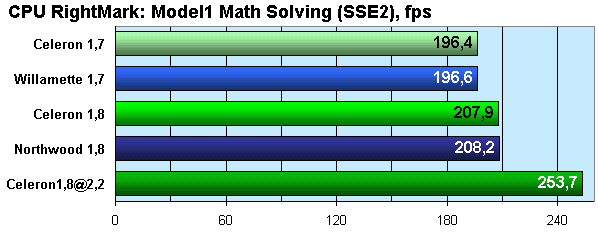 In the CPU RightMark benchmark we consider only the results obtained with the SSE/SSE2 instructions. As the algorithm of the equation solving unit doesn't imply exchange of large data volumes with the memory, the cache size of the new processor is sufficient, that is why the performance depends directly on the frequency.
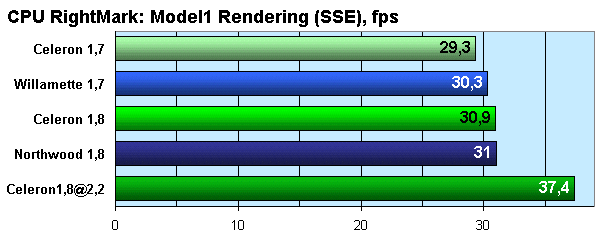 In the rendering, the cache makes a greater contribution (just look at the pair of Willamette-Celeron) and the Northwood goes very close to its competitor. The L2 cache speed of the Northwood is just a little lower than that of the Willamette, and this speed either smoothes away the effect of the large cache or the volume over 256 KBytes is not used effectively by the rendering unit. Anyway, it's only the CPU frequency that influences the performance, and in both computation units the overclocked Celeron (2.2 GHz) takes a confident lead.
 MP3 encoding is also a computational task, and as you can see even the larger cache doesn't help the Pentium 4 "Willamette" to do away with the 100 MHz gap. But at the expense of this large cache the Northwood outscores the same-frequency Celeron by a greater margin than the Willamette its mate.
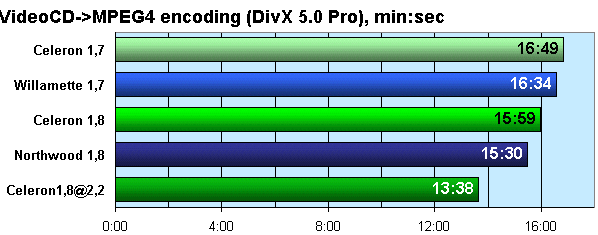 This test proves that the cache size doesn't affect much the MPEG4 encoding. The difference in the results grows proportionally to the cache size, but in the end it is only 3% for the pair of Northwood-Celeron. The overclocked Celeron is, as always, far ahead.
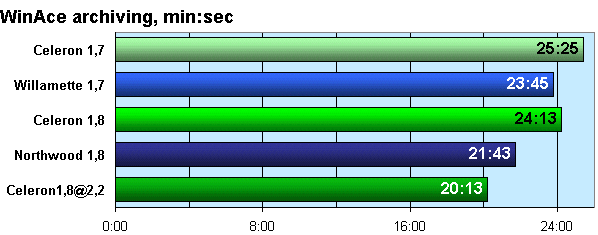 Well, here the effect from the cache size is really great. The Willamette outpaces the Celeron working at the same frequency by 7%, and the Northwood does it by 12%! Note that the system overclocking (the memory overclocking is more important this time) helps the Celeron@2.2 to remain the leader.
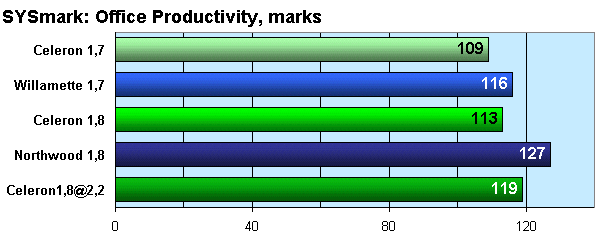
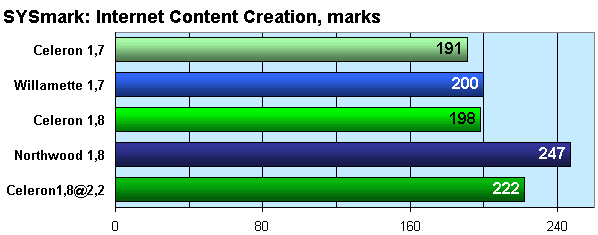 In the SYSmark the Willamette outdoes the Celeron which runs at the frequency higher by 100 MHz; and it is the first time when the Northwood becomes an absolute leader. The Celeron overclocked by over 20% still loses to the larger cache in the test which puts a great load on the processor, bus and memory.
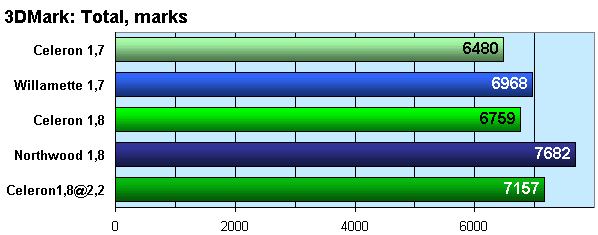
 Yet in the SYSmark the Celeron was behind the Northwood by over 10%, sometimes even by 20%. This tendency remains in the games. ConclusionThe new Celeron processors haven't failed in the tests. That's good. In pure computational tasks they go on a par with the Pentium 4 of the same frequency, and in the operations which do not load several components of the platform simultaneously they perform like the "Willamette minus 100 MHz", and only in the tougher tests they start losing because they can't cover huge holes of the architecture with their small caches even when overclocked. The gap is not too awful, and Intel will probably finish the transition to the single socket successfully, and after that, with the increased frequency, finer fab process, larger (possibly) cache the new Celeron will look very attractive. But I don't see much sense in such movements. It's clear that Intel wants to produce and sell the new processors; it's also clear that the performance will be rather good, and it will be possible to assemble quite a cheap system (low-end) based on the Willamette-128 joining the efforts of manufacturers of chipsets, mainboards, cooling devices and system cases (the processor does allow for it - the 1.7 GHz version is expected at $90)... But I must say again that users do not need such movements in the low-end sector - current platforms for the Socket 370 are more than enough.
P.S. Write a comment below. No registration needed!
|
Platform · Video · Multimedia · Mobile · Other || About us & Privacy policy · Twitter · Facebook Copyright © Byrds Research & Publishing, Ltd., 1997–2011. All rights reserved. |